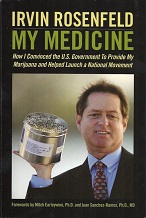Gliomas (brain tumors) are especially aggressive malignant forms of cancer often it results in death of affected patients within one to two years after diagnosis. There is no cure for gliomas and most treatments only provide symptomatic relief mild.
A review of modern scientific literature reveals a pilot demonstrating the ability of cannabinoids to act as antineoplastic agents, especially glioma cell lines numerous preclinical and clinical studies.
Writing in the issue of FEBS Letters in September 1998, researchers at the Complutense University of Madrid, School of Biology, first reported that delta-9-THC induced apoptosis (programmed cell death) in glioma cells in culture. [1] The researchers followed their initial findings in 2000, reporting that the administration of both THC and the synthetic cannabinoid agonist WIN 55,212-2 "induced a considerable regression of malignant gliomas" in animals. [2] researchers confirmed again capability of cannabinoids to inhibit tumor growth in animals in 2003. [3]
That same year, Italian researchers at the University of Milan, Department of Pharmacology, Chemotherapy and Toxicology, said the non-psychoactive cannabinoid cannabidiol (CBD), inhibits the growth of various human glioma cell lines in vivo and in vitro a dose dependent manner. In the edition of the Journal of Pharmacology and Experimental Therapeutics Fast Forward November 2003, the researchers concluded that "the non-psychoactive CBD can produce significant antitumor activity both in vitro and in vivo, suggesting a possible application of CBD as an agent antineoplastic ". [4]
In 2004, Guzman and colleagues reported that cannabinoids inhibit glioma tumor growth in animals and in human glioblastoma multiforme (GBM) tumor specimens by altering the morphology of the blood vessels (e.g. VEGF pathways). In the edition of Cancer Research August 2004, the researchers concluded that "The study of laboratory and clinical findings provide a new pharmacological line for cannabinoid-based therapies." [5]
Researchers at the Research Institute of the California Pacific Medical Center reported that the administration of THC in human glioblastoma multiforme cell lines decreased the proliferation of malignant cells and induced cell death more quickly than did the administration of WIN 55,212-2 . The researchers also found that THC selectively targets malignant cells regardless healthy for deeper than synthetic Alternatively. [6] In a separate preclinical trial reported that combined administration of THC and temozolomide (TMZ) "The enhanced autophagy (programmed cell death) in brain tumors resistant to conventional cancer treatments" [7]
Guzman and his colleagues have also reported that the administration of THC reduces tumor growth in recurrent glioblastoma multiforme patients diagnosed with recurrent GBM. In the first pilot clinical trial evaluating the use of cannabinoids and GBM, the researchers found that intratumoral administration of THC was associated with reduced tumor cell activity in two of the nine patients "reasonable safety profile of THC, and its possible antiproliferative action on tumor cells reported here and in other studies, can provide the basis for future trials aimed at evaluating the potential antitumoral activity of cannabinoids, "the researchers concluded. [8] Several other researchers have also recently called for further exploration of cannabis-based therapies for the treatment of glioma. [9-11] A separate case, published in 2011 in the journal of the International Society for Pediatric Neurosurgery, also documents the spontaneous regression of residual brain tumors two children making use of cannabis. [12]
Besides the capability of cannabinoids to moderate glioma cells, separate studies demonstrate that cannabinoids and endocannabinoids may also inhibit the proliferation of various other cancer cell lines, including breast cancer [13-17] carcinoma Prostate, [18-22] colorectal carcinoma [23-24] gastric cancer [25], skin carcinoma, [26] the leukemia cells [27-30] neuroblastoma, [31-32] lung carcinoma, [33-34] The uterus carcinoma [35], thyroid epithelioma, [36] pancreatic adenocarcinoma [37-38] The cervical carcinoma, [39] oral cancer [40], cancer of the bile ducts ( cholangiocarcinoma) [41] and lymphoma. [42-43].
Consequently, some experts now believe that cannabinoids "may represent a new class of cancer drugs that slow cancer growth, inhibit angiogenesis and metastatic spread of cancer cells." [44-45] "These compounds are Cheap to produce and make better use of their unique properties may result in more cost-effective anti-cancer drugs in the future. " [46] Israeli doctors are now recommending that treatment with cannabinoids will be offered to patients in the early stages of cancer. "[47]
REFERENCES
[1] Guzman et al. 1998. Delta-9-tetrahydrocannabinol you induce apoptosis in C6 glioma cells. FEBS Letters 436: 6-10.
[2] Guzman et al. 2000. Anti-tumor action of cannabinoids: Involvement of sustained ceramide accumulation and extracellular signal-regulated kinase activation. Nature Medicine 6: 313-319.
[3] Guzman et al. 2003. Inhibition of tumor angiogenesis by cannabinoids. The FASEB Journal 17: 529-531.
[4] Massi et al. 2004. Antitumor effects of cannabidiol, a non-psychotropic cannabinoid, on human glioma cell lines. Journal of Pharmacology and Experimental Therapeutics Fast Forward 308: 838-845.
[5] Guzman et al. 2004. Cannabinoids inhibit the vascular endothelial growth factor pathways in gliomas (PDF). Cancer Research 64: 5617-5623.
[6] Allister et al. 2005. Cannabinoids selectively inhibit proliferation and induce death of cultured human glioblastoma multiforme cells. Journal of Neurooncology 74: 31-40.
[7] Torres et al. 2011. A combined therapy of cannabinoids and preclinical Temozolomide Against glioma. Cannabis Molecular Therapeutics 10: 90.
[8] Guzman et al. 2006. A pilot clinical study of delta-9-tetrahydrocannabinol in patients With recurrent glioblastoma multiforme. British Journal of Cancer (E-pub ahead of print).
[9] Parolaro and Massi. 2008. Cannabinoids as a potential new drug therapy for the treatment of gliomas. Expert Reviews of Neurotherapeutics 8: 37-49
[10] Galanti et al. 2007. Delta9-Tetrahydrocannabinol Inhibits cell cycle progression by downregulation of E2F1 in human glioblastoma multiforme cells. Oncologica Act 12: 1-9.
[11] Calatozzolo et al. 2007. Expression of cannabinoid receptors and neurotrophins in human gliomas. Neurological Sciences 28: 304-310.
[12] Foroughi et al. 2011. Spontaneous regression of septum pellucidum / forniceal pilocytic astrocytomas - possible role of cannabis inhalation. Child's Nervous System 27: 671-679.
[13] Cafferal et al. 2006. Delta-9-Tetrahydrocannabinol Inhibits cell cycle progression in human breast cancer cells Cdc2-through regulation. Cancer Research 66: 6615-6621.
[14] Di Marzo et al. 2006. Anti-tumor activity of plant cannabinoids With emphasis on the effect of cannabidiol on human breast carcinoma. Journal of Pharmacology and Experimental Therapeutics Fast Forward 318: 1375-1387.
[15] Petrocellis et al. 1998. The endogenous cannabinoid anandamide Inhibits human breast cancer cell proliferation. Proceedings of the National Academy of Sciences of the United States of America 95: 8375-8380.
[16] McAllister et al. 2007. Cannabidiol as a novel inhibitor of Id-1 gene expression in aggressive breast cancer cells. Molecular Cancer Therapeutics 6: 2921-2927.
[17] Cafferal et al. 2010. Cannabinoids reduce ErbB2-driven breast cancer progression-through Akt inhibition. Molecular Cancer 9: 196.
[18] Sarfaraz et al. 2005. Cannabinoid receptors as a novel target for the treatment of prostate cancer. Cancer Research 65: 1635-1641.
[19] Mimeault et al. 2003. Anti-proliferative and apoptotic effects of anandamide in human prostatic cancer cell lines. Prostate 56: 1-12.
[20] Ruiz et al. 1999. Delta-9-tetrahydrocannabinol you induce apoptosis in human prostate PC-3 cells via a receptor-independent mechanism. FEBS Letters 458: 400-404.
[21] Ramos and Bianco. 2012. The role of cannabinoids in prostate cancer: Basic science perspective and potential clinical applications. Journal of Urology 28: 9-14.
[22] DePetrocellis et al. 2013. Non-THC cannabinoids inhibit prostate cancer growth in vitro and in vivo: pro-apoptotic effects and underlying Mechanisms. British Journal of Pharmacology 168: 79-102.
[23] Pasture et al. 2005. The endogenous cannabinoid, anandamide, you induce cell death in colorectal carcinoma cells: a possible role for cyclooxygenase-2. Gut 54: 1741-1750.
[24] Aviello et al. 2012. Chemopreventive effect of the non-psychotropic phytocannabinoid cannabidiol on experimental colon cancer. Journal of Molecular Medicine [E-pub ahead of print]
[25] Di Marzo et al. 2006. op. cit
[26] Casanova et al. Inhibition of skin tumor growth and angiogenesis in vivo by activation of cannabinoid receptors. 2003. Journal of Clinical Investigation 111: 43-50.
[27] Powles et al. 2005. Cannabis-induced cytotoxicity in leukemic cell lines. Blood 105: 1214-1221
[28] Jia et al 2006. Delta-9-tetrahydrocannabinol-induced apoptosis in Jurkat T cells in leukemic regulated by translocation of Bad to mitochondria. Molecular Cancer Research 4: 549-562.
[29] Liu et al. 2008. Enhancing the in vitro cytotoxic activity of A9-tetrahydrocannabinol in leukemic cells Through a combinatorial approach. Leukemia and Lymphoma 49: 1800-1809.
[30] Scott et al. 2013. Enhancing the activity of cannabidiol and other cannabinoids in vitro Through Modifications to drug combinations and treatment schedules 33: 4373-4380.
[31] Manuel Guzman. 2003. Cannabinoids: potential anticancer agents (PDF). Nature Reviews Cancer 3: 745-755.
[32] Marcu et al. 2010. Cannabidiol Enhances the inhibitory effects of delta9-tetrahydrocannabinol on human glioblastoma cell proliferation and survival. Molecular Cancer Therapeutics 9: 180-189.
[33] Guzman. 2003 op. cit.
[34] Preet et al. 2008. Delta9-Tetrahydrocannabinol Inhibits epithelial growth factor-induced lung cancer cell migration in vitro as well as STI growth and metastasis in vivo. Oncogene 10: 339-346.
[35] Manuel Guzman. 2003. Cannabinoids: potential anticancer agents (PDF). Nature Reviews Cancer 3: 745-755.
[36] Baek et al. 1998. Antitumor activity of cannabigerol against human oral epitheloid carcinoma cells. Archives of Pharmacal Research 21: 353-356.
[37] Carracedo et al. 2006. Cannabinoids induce apoptosis of pancreatic tumor cells via endoplasmic reticulum stress-related genes. Cancer Research 66: 6748-6755.
[38] Michalski et al. 2008. Cannabinoids in pancreatic cancer: correlation With survival and pain. International Journal of Cancer 122: 742-750.
[39] Ramer and Hinz. 2008. Inhibition of cancer cell invasion by cannabinoids via Increased cell expression of tissue inhibitor of matrix metalloproteinases-1. Journal of the National Cancer Institute 100: 59-69.
[40] Whyte et al. 2010. Cannabinoids inhibit cellular respiration of human oral cancer cells. Pharmacology 85: 328-335.
[41] Leelawat et al. 2010. The dual effects of delta (9) -tetrahydrocannabinol on cholangiocarcinoma cells: anti-invasion activity at low concentration and apoptosis induction at high concentration. Cancer Investigation 28: 357-363.
[42] Gustafsson et al. 2006. Cannabinoid receptor-mediated apoptosis induced by R (+) - methanandamide and WIN55,212 is Associated With ceramide accumulation and p38 activation in mantle cell lymphoma. Molecular Pharmacology 70: 1612-1620.
[43] Gustafsson et al. 2008. Expression of cannabinoid receptors type 1 and type 2 in non-Hodgkin lymphoma: Growth inhibition by receptor activation. International Journal of Cancer 123: 1025-1033.
[44] Natalya Kogan. 2005. Cannabinoids and cancer. Mini-Reviews in Medicinal Chemistry 5: 941-952.
[45] Sarafaraz et al. 2008. Cannabinoids for cancer treatment: progress and promise. Cancer Research 68: 339-342.
[46] Study shows non-hallucinogenic cannabinoids are effective anti-cancer drugs. October 14, 2013.
[47] Haartz. Israeli Researchers say more Should doctors recommend marijuana to cancer patients. January 30, 2012.
Latest
Coronavirus Strikes Massachusetts Cannabis Company Employees
Reassessing the Essential: Cannabis in the Time of a Pandemic
5 Reasons To Try Aspen Valley CBG Flower (30% Off)
High Times Cannabis Cups Go Virtual In Wake Of Coronavirus Pandemic
Drug Enforcement Administration Proposes Plan To Expand Cannabis Research
Ghana Legalizes Cannabis For Medicinal And Industrial Uses
The cheapest legal weed in Canada: Discover these cannabis ‘value brands’
Cannabis and coronavirus: Here’s what you need to know
cannabis designs
The Best Of
WHO Rules CBD Should Not Be a Scheduled Drug

Dr Cristina Sanchez PhD video interview on medical marijuana and cancer

Biochemist Dennis Hill interview; Cannabis oil as a cure for cancer.

The unofficial World Record holder for cannabis smoking part 1





